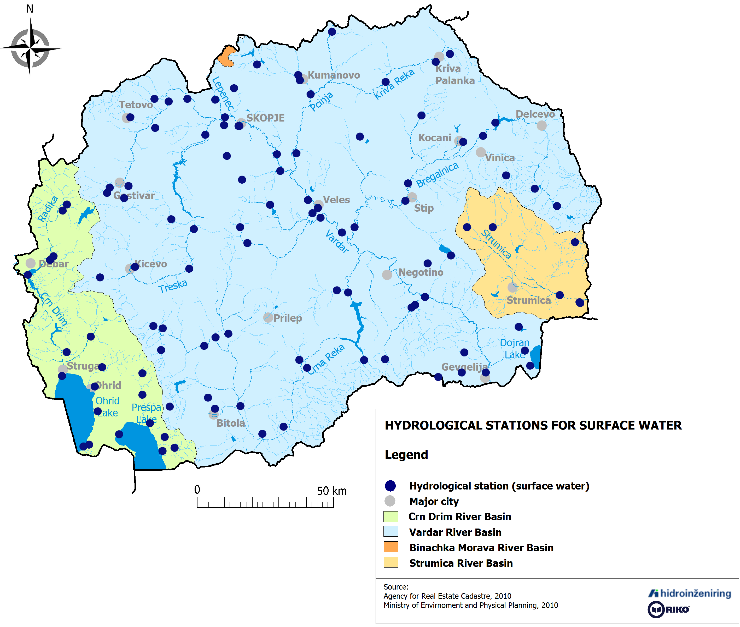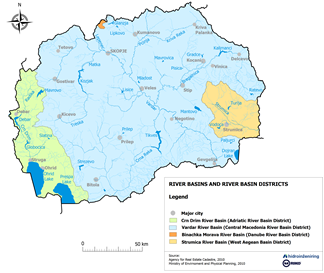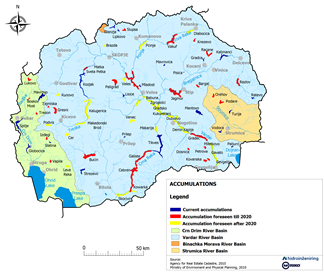Country acquired Candidate Country status in 2005 and on 18th February 2008 the European Council adopted the Accession Partnership.
The alignment of national legislation with EU requirements is carried out in accordance with the National Programme for Adoption of the Acquis (NPAA), and in the area of environment, in line with the National Environmental Action Plan (NEAP).
The water sector faces considerable challenges in the coming years:
- Meeting the EU requirements for wastewater collection and treatment and achieving full compliance with the Drinking Water Directive (DWD),
- The increasing costs of replacing aging infrastructure – a capital maintenance backlog has arisen due to a lengthy period of very low investment in asset replacement
- Maintaining tariffs at an affordable level during a period of low economic growth
- Institutional and organizational reform, professionalization and achievement of economies of scale.
Institutional aspects
The obligations for compliance with the water related directives are capital intensive and for waste water collection and treatment alone are estimated at around 700 million Euros. (COWI 2010). The implementation of such a capital intensive programme puts stress on the financial capacity of the country and the local beneficiaries. However, equally the management of the programme puts pressure on the institutions which are responsible for its implementation. This, paired with the limited capacities in the relevant institutions, requires:
- Cost effectiveness in all phases of implementation of the programme;
- Clear institutional responsibilities avoiding overlaps;
- Transparent methods for cooperation and coordination;
- Involvement of stakeholders early in and throughout the process;
- Strengthening of the administrative capacity and staff capabilities.

Water Sector policies
The preparation and implementation of the programme for improvements in the water sector requires a policy as to where the water sector will be heading in the next decennia in particular because Country has relatively limited water resources.
There are competing interests for the use of water resources, in particular hydropower, agriculture and water supply. These interests need to be balanced such that all basic functions are satisfied where possible. On the other hand, the quality of water resources and water bodies is under pressure as a result of pollution from point sources and dispersed sources having impact on the availability of water for specific purposes (e.g. drinking water supply). A solid monitoring system, data collection, data management and data evaluation forms the basis for the development of a sustainable water policy.
Monitoring and data management
The general river monitoring strategy is based on international experience and modern concepts. The River Monitoring System Project (RIMSYS) is a cooperative project with government of Switzerland, and is designed to revitalize the 40-year-old national river monitoring system in the country.
Despite the progress which has been made in achieving a high standard for monitoring, a number of recent studies report lack of data to achieve the required results Implementation of the UWWTD In the last years a number of larger projects have entered into the process of project preparation and implementation; however, Country still has to formulate its programme to establish a large number of projects in order to reach compliance with the UWWTD Directive. The current priority setting is based on the “largest reduction of environmental impact” hence projects have been selected which serve the major urban areas. For the implementation of the large number of remaining projects a clear strategy is required for project preparation and implementation based on agreed criteria for priority setting. The priorities shall be established in the Directive Specific Implementation Plan (DSIP) for waste water which shall be: Implementation of the DWD A comprehensive, coordinated and managed system which integrates the information and data of water supply areas (e.g. area, sources, coverage, monitoring, and water quality) is required in order to collect and provide information on: It would be helpful if the system could also directly address the reporting requirements as required by the DWD. In the course of improving the (waste) water infrastructure within the agglomerations the Municipalities/PUCs may want to improve the water supply infrastructure either by extension and/or reconstruction. These activities in general are not directly related to compliance with the DWD but may still be co-financed. The objectives for increasing the coverage or improvement of the systems to ensure long term manageability are a matter of national policy and the EU financial support needs to be agreed with the European Commission. Sensitive areas Sensitive areas (UWWTD art 5, Law on Water Art 103) have not yet been defined. In 2011 a short analysis was made, based on the situation in the neighbouring countries It was concluded that “It is highly plausible that the Vardar, Strumica and Juzna Morava river basins will be defined as sensitive areas, counting for 87% of the territory of the country. The basin feeding the Ohrid Lake is already declared sensitive. No data are available to provide a plausible expectation for the Crn Drin Basin.” A detailed analysis is required and a list of sensitive areas needs to be drafted for decision by the Government after which the list is submitted to the EU including information as required for reporting in WISE. Delineation of Agglomerations Agglomerations form the basis for the implementation of the requirements of the UWWTD. Whereas the term “agglomeration” is defined as such in Art. 2.4 of the UWWTD, the actual practical delineation of the agglomerations leaves room for interpretation. A methodology and set of criteria is required to do the actual delineation of the agglomerations which fulfils the definition in the UWWTD, which is effective with regard to the environmental achievements and is feasible in terms of financing, and affordability. Drinking water supply areas For drinking water areas comprehensive information needs to be gathered to assess for each supply area: Sludge management The implementation of projects for waste water treatment results in the generation of waste water sludge. The generated amount of sludge will grow in line with the actual implementation of waste water treatment facilities. A timely and feasible solution for treatment and disposal of sludge shall be agreed upon and investments shall be planned. Programme management The management of a major investment program, including both Waste Water Collection and Treatment and Water Supply needs clearly defined roles and responsibilities divided according to the project phases. Because of limited staffing resources the roles and responsibilities of involved stakeholders, for each phase of the project cycle, need be defined and the capacity shall be built. This project aims at: [1] Preliminary river basin management plan for Strumica River Basin District (PointPro 2015)
 The water services sector continues to deliver reliable water supply services to most citizens. Access to water services is good, as reported by the Danube Water Program, with access to piped water being 92% and access to flush toilet being 86%.
The water services sector continues to deliver reliable water supply services to most citizens. Access to water services is good, as reported by the Danube Water Program, with access to piped water being 92% and access to flush toilet being 86%.
 For achievement of the requirements of the DWD a system of monitoring shall be in place which is in line with the Directive (as transposed in the Law on Waters and secondary legislation) and ensures that the quality of the supplied water is in accordance with pre-defined criteria. The 2015 amendment to the DWD provides a more flexible system of monitoring which can be tailored to the local conditions.
For achievement of the requirements of the DWD a system of monitoring shall be in place which is in line with the Directive (as transposed in the Law on Waters and secondary legislation) and ensures that the quality of the supplied water is in accordance with pre-defined criteria. The 2015 amendment to the DWD provides a more flexible system of monitoring which can be tailored to the local conditions.
Technical assistance for strengthening the institutional capacities for approximation and implementation of environmental legislation in the area of water management (Ramboll 2015)
[2] “Commission staff working document the former Yugoslav Republic of Macedonia report” 2015


Follow us & Share